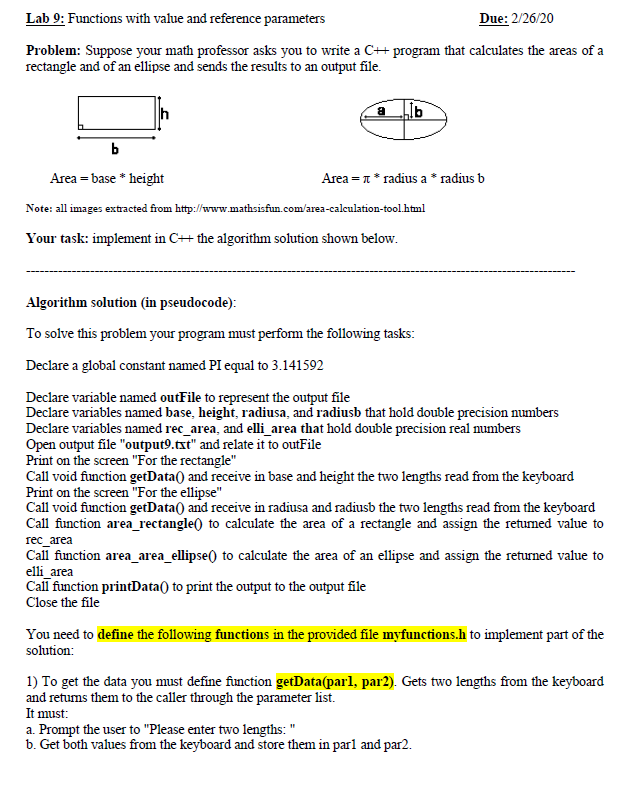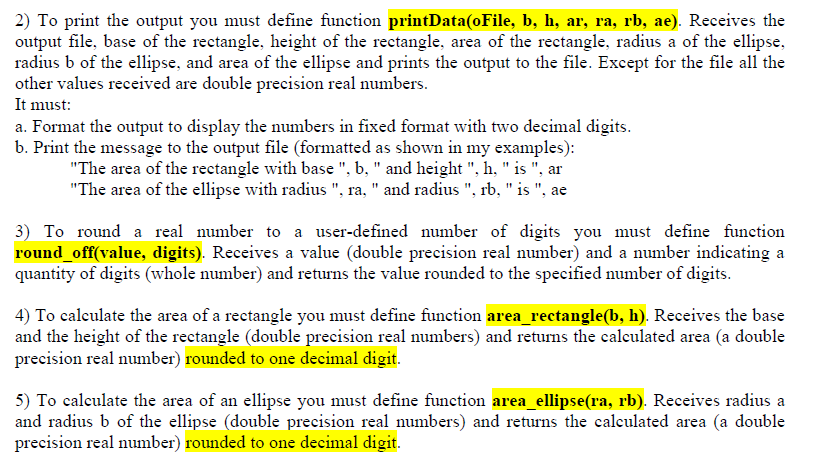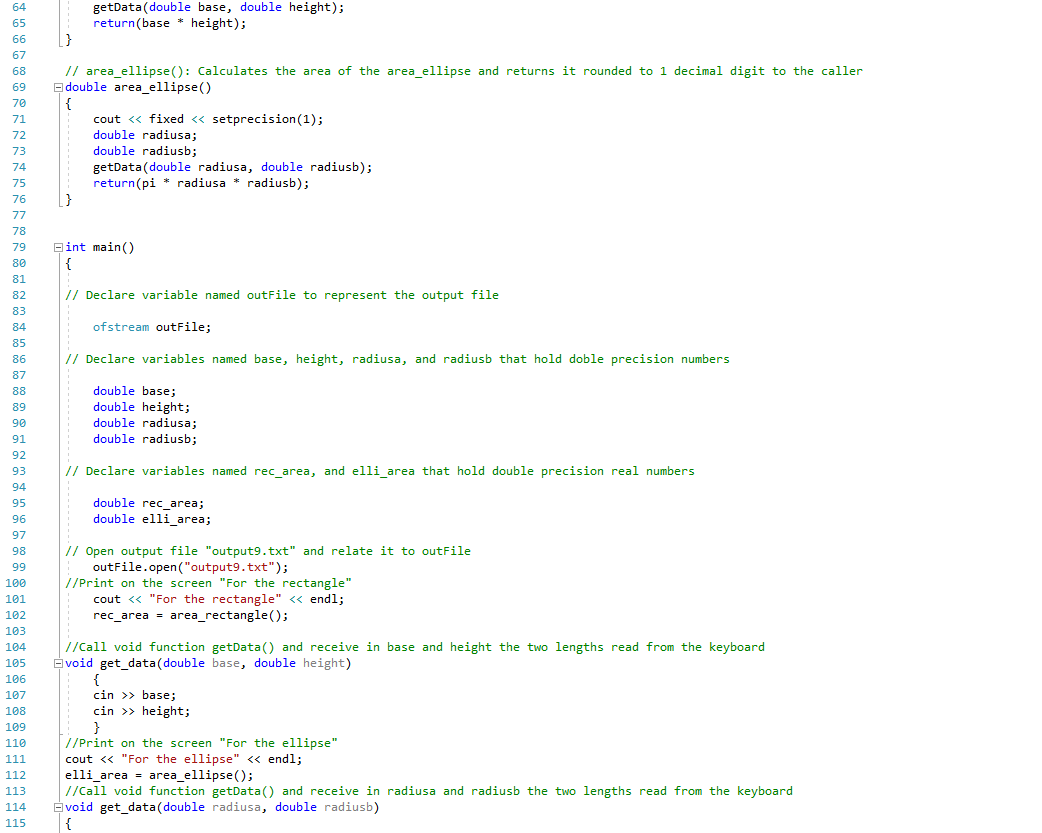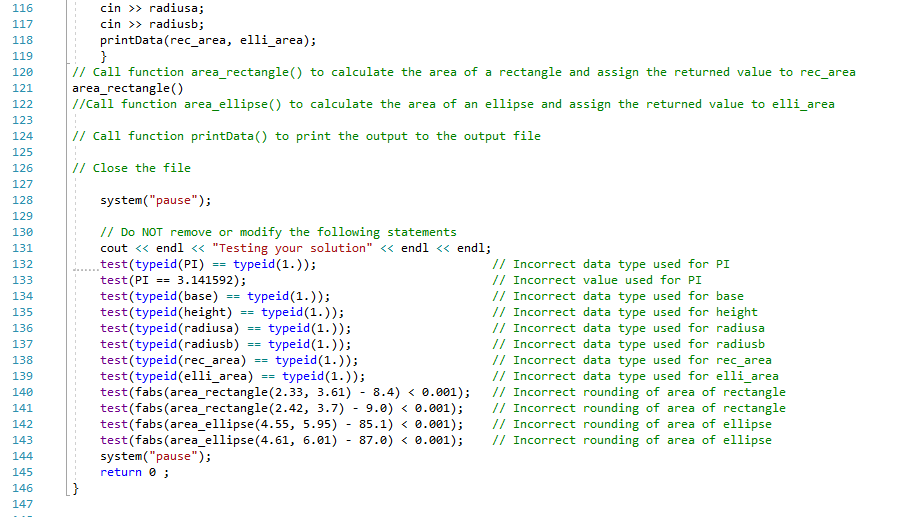// // Program Description: This program was made to calcute the area of a rectangle and of an ellipse. // /////////////////////////////////////////////////////////////////////
#include // to use cin and cout #include // to be able to use operator typeid
// Include here the libraries that your program needs to compile
#include using namespace std ;
// Ignore this; it's a little function used for making tests inline void _test(const char* expression, const char* file, int line) { cerr
// Declare a global constant named PI equal to 3.141592
const double PI = 3.141592;
// Include your functions file here //************************ Function definitions ************************* // Read the handout carefully for detailed description of the functions that you have to implement
// round_off(): Rounds the value received in the first parameter to the number of digits received in the second parameter
// getData(): Gets two lengths from the keyboard and returns them to the caller void getData(double par1, double par2) { cout > par1; cin >> par2; }
// printData(): Receives the output file, base of the rectangle, height of the rectangle, area of the rectangle, // radius a of the ellipse, radius b of the ellipse, and area of the ellipse and prints the output to the file
// area_rectangle(): Calculates the area of the rectangle and returns it rounded to 1 decimal digit to the caller void area_rectangle() { cout > height; cin >> base; }
// area_ellipse(): Calculates the area of the area_ellipse and returns it rounded to 1 decimal digit to the caller double area_ellipse() { cout
int main() {
// Declare variable named outFile to represent the output file
// Declare variables named base, height, radiusa, and radiusb that hold doble precision numbers double base; double height; double radiusa; double radiusb;
// Declare variables named rec_area, and elli_area that hold double precision real numbers double rec_area; double elli_area;
// Open output file "output9.txt" and relate it to outFile
//Print on the screen "For the rectangle" cout
//Call void function getData() and receive in base and height the two lengths read from the keyboard void getData(double &base, double &height); cout > base; cout > height; cout
//Print on the screen "For the ellipse" cout
cin >> radiusa; cin >> radiusb; getData(rec_area, elli_area); // Call function area_rectangle() to calculate the area of a rectangle and assign the returned value to rec_area area_rectangle() //Call function area_ellipse() to calculate the area of an ellipse and assign the returned value to elli_area
// Call function printData() to print the output to the output file
// Close the file
system("pause");
// Do NOT remove or modify the following statements cout
The code shown below is what I have but I'm having trouble with the void printData part, can you please help me fix whatever errors you see and explain what I'm doing wrong, thanks.





Lab 9: Functions with value and reference parameters Due: 2/26/20 Problem: Suppose your math professor asks you to write a C# program that calculates the areas of a rectangle and of an ellipse and sends the results to an output file. Ab Area = base * height Area=1* radius a * radius b Note: all images extracted from http://www.mathsisfun.com/area-calculation tool.html Your task: implement in C# the algorithm solution shown below. Algorithm solution (in pseudocode): To solve this problem your program must perform the following tasks: Declare a global constant named PI equal to 3.141592 Declare variable named outFile to represent the output file Declare variables named base, height, radiusa, and radiusb that hold double precision numbers Declare variables named rec_area, and elli_area that hold double precision real numbers Open output file "output9.txt" and relate it to outFile Print on the screen "For the rectangle" Call void function getData() and receive in base and height the two lengths read from the keyboard Print on the screen "For the ellipse" Call void function getData() and receive in radiusa and radiusb the two lengths read from the keyboard Call function area_rectangle to calculate the area of a rectangle and assign the retumed value to rec area Call function area_area_ellipse() to calculate the area of an ellipse and assign the returned value to elli_area Call function printData() to print the output to the output file Close the file You need to define the following functions in the provided file myfunctions.h to implement part of the solution: 1) To get the data you must define function getData(parl, par2). Gets two lengths from the keyboard and returns them to the caller through the parameter list. It must: a. Prompt the user to "Please enter two lengths: " b. Get both values from the keyboard and store them in parl and par2. 2) To print the output you must define function printData(oFile, b, h, ar, ra, rb, ae). Receives the output file, base of the rectangle, height of the rectangle, area of the rectangle, radius a of the ellipse, radius b of the ellipse, and area of the ellipse and prints the output to the file. Except for the file all the other values received are double precision real numbers. It must: a. Format the output to display the numbers in fixed format with two decimal digits. b. Print the message to the output file (formatted as shown in my examples): "The area of the rectangle with base", b," and height", h, "is", ar "The area of the ellipse with radius", ra," and radius", rb, "is", ae 3) To round a real number to a user-defined number of digits you must define function round_off(value, digits). Receives a value (double precision real number) and a number indicating a quantity of digits (whole number) and returns the value rounded to the specified number of digits. 4) To calculate the area of a rectangle you must define function area rectangle(b, h). Receives the base and the height of the rectangle (double precision real numbers) and returns the calculated area (a double precision real number) rounded to one decimal digit. 5) To calculate the area of an ellipse you must define function area_ellipse(ra, rb). Receives radius a and radius b of the ellipse (double precision real numbers) and returns the calculated area (a double precision real number) rounded to one decimal digit. #include
#include // to use cin and cout // to be able to use operator typeid // Include here the libraries that your program needs to compile #include using namespace std; // Ignore this; it's a little function used for making tests Qinline void _test(const char* expression, const char* file, int line) cerr > parl; cin >> par2; // printData(): Receives the output file, base of the rectangle, height of the rectangle, area of the rectangle, [1/ radius a of the ellipse, radius b of the ellipse, and area of the ellipse and prints the output to the file void printData(double rec_area, double elli_area) cout > base; cin >> height; 111 112 1/Print on the screen "For the ellipse" cout > radiusa; cin >> radiusb; printData(rec_area, elli_area); // Call function area_rectangle() to calculate the area of a rectangle and assign the returned value to rec_area area_rectangle() I/Call function area_ellipse() to calculate the area of an ellipse and assign the returned value to elli_area 1/ Call function printData() to print the output to the output file 1/ Close the file system("pause"); // DO NOT remove or modify the following statements cout #include // to use cin and cout // to be able to use operator typeid // Include here the libraries that your program needs to compile #include using namespace std; // Ignore this; it's a little function used for making tests Qinline void _test(const char* expression, const char* file, int line) cerr > parl; cin >> par2; // printData(): Receives the output file, base of the rectangle, height of the rectangle, area of the rectangle, [1/ radius a of the ellipse, radius b of the ellipse, and area of the ellipse and prints the output to the file void printData(double rec_area, double elli_area) cout > base; cin >> height; 111 112 1/Print on the screen "For the ellipse" cout > radiusa; cin >> radiusb; printData(rec_area, elli_area); // Call function area_rectangle() to calculate the area of a rectangle and assign the returned value to rec_area area_rectangle() I/Call function area_ellipse() to calculate the area of an ellipse and assign the returned value to elli_area 1/ Call function printData() to print the output to the output file 1/ Close the file system("pause"); // DO NOT remove or modify the following statements cout











